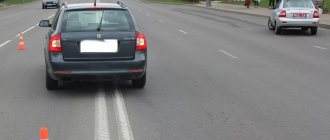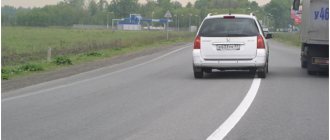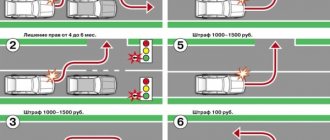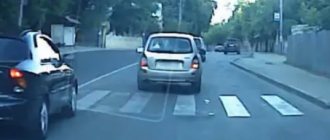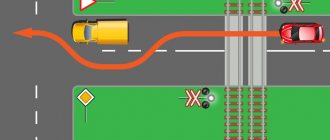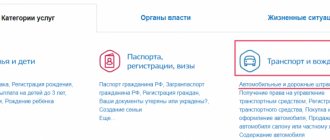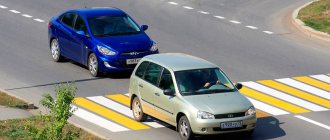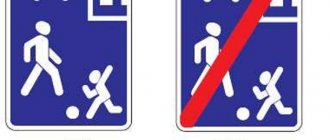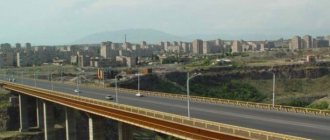There are often situations when a bus is located at a stop in such a way for boarding and disembarking passengers that it completely blocks the passage for the driver. At the same time, overtaking or detour is not allowed in this case.
Dear readers! The article talks about typical ways to resolve legal issues, but each case is individual. If you want to find out how to solve your particular problem , contact a consultant:
+7 (499) 938-81-90 (Moscow)
+7 (812) 467-32-77 (Saint Petersburg)
8 (800) 301-79-36 (Regions)
APPLICATIONS AND CALLS ARE ACCEPTED 24/7 and 7 days a week.
It's fast and FREE !
It is important to deal with this point in advance, and also to decide in advance for what exactly the traffic police officers will have the right to punish the driver of the vehicle.
What does solid mean?
Today, various marking schemes are used on public roads.
They simultaneously perform several different functions:
- mark acceptable trajectories for drivers;
- indicate the possibility of performing certain maneuvers;
- other.
It is very important for every driver to know what exactly this or that marking means. And also the color.
Since depending on it, the designation of this type of traffic order will differ. For example, if the markings are yellow, this has a special meaning.
You need to be especially careful with continuous markings. Since violation of the traffic regime through it in some cases implies not just a fine, but also deprivation of a driver’s license.
For example, such a maneuver as turning or turning across a solid marking line will imply the deprivation of a driver's license. A solid marking line is designated as 1.1.
It is important and is interpreted taking into account two points at once:
- road markings of this type are usually used in the “inner” part of the road surface, and not along the edge;
- Marking 1.1 is strictly not allowed to be crossed from any side - and in any case, not only when turning or overtaking.
It is on the basis of the points outlined above that it is necessary to “use” such markings. Moreover, it is worth noting that there are a number of combination options for continuous markings.
The most common options:
- solid single type – used on roads with two or three lanes – indicates a prohibition on entering the oncoming lane, regardless of various circumstances;
- if the markings on sharp turns become intermittent after which it becomes solid again - this does not mean a change in its meaning; the ban on entering the oncoming lane will still apply.
For violation of the rules regarding maneuvers through markings, in some cases a fine or imprisonment is implied.
Moreover, the assignment of any specific punishment directly depends on the exact circumstances in which a particular violation takes place.
Moreover, it is important to distinguish between the following two concepts, which are often deliberately confused by traffic police officers when classifying a violation:
- avoiding obstacles on the road, getting ahead;
- overtaking.
Bus stop
Stopping means deliberately stopping the movement of a vehicle for a total duration of less than 5 minutes. The stop can also be made for a longer period of time, if this is required for boarding and disembarking passengers or unloading vehicles.
A vehicle that stops due to a traffic jam has not stopped and cannot be considered an obstruction. Documentation? In accordance with the rules of the road, it cannot be considered a traffic stop in cases provided for by law:
- When a vehicle approaches a car with the signal beacon turned on, in order to be able to quickly stop if necessary.
- If the requirement to stop the vehicle was given over a loudspeaker or another signal from a traffic controller or inspector.
- When there is a prohibitory traffic light.
- If the stop was made by a slow-moving vehicle moving at a speed of less than 30 kilometers per hour. In this case, if for some reason it is impossible to get ahead of such a vehicle, its driver must press to the right side of the road and stop to let the cars behind him pass.
- When stopping a car in front of a pedestrian crossing.
- When there is a prohibitory signal about crossing a crossing.
- When the driver is blinded.
Overtaking or bypassing a bus standing at a stop
It is necessary to understand the term “overtaking” in advance. The legislation and traffic rules provide a fairly clear and precise definition of what constitutes overtaking.
This maneuver involves entering the oncoming lane of traffic by changing lanes and returning to it. Advancing is moving at a speed exceeding the speed of the vehicle driving next to you.
It is equally important to understand the meaning of the term “obstacle avoidance”. This refers to a maneuver involving leaving the occupied lane into the oncoming lane and then changing lanes. In this case, there must be an obstacle.
Often there is no pocket at the bus stop. For this reason, it is necessary to detour around it. And in the absence of a broken marking line, this will be a serious violation.
It is worth remembering that driving in violation does not imply deprivation of your driver's license. At the same time, overtaking through a solid line means 100% deprivation of your driver's license.
That is why traffic police officers usually try to create a detour for overtaking. Moreover, they do this deliberately, often with the aim of extorting money.
Therefore, it is important to familiarize yourself with the regulatory documentation, traffic rules and the Code of Administrative Offenses of the Russian Federation in advance. This will allow you to independently protect your own rights. Prevent a variety of other problems.
How much it costs to buy an overtaking mirror for right-hand drive cars is shown in the article: overtaking mirror for right-hand drive cars. Is it prohibited to overtake on a hill? Read here.
Is it possible to bypass a bus that is parked at a stop?
Safe driving is only permissible if all drivers comply with traffic rules. It is impossible to memorize all the points; it is much easier to understand once and then not encounter difficulties on the road.
In real life, it is simply impossible for absolutely all participants to comply with traffic rules. Many cannot understand these rules, while others simply do not want to. The most common violation among motorists is crossing a solid line. However, this is not the worst case yet. Very often, drivers are punished for a combination of several offenses at once. For example, a detour for public transport that is located near a stop. Let's consider how to act in this situation according to the law.
Detour is . This is how the traffic rules define a maneuver when one vehicle leaves its lane into the oncoming lane, and subsequently changes lanes. If the driver resorts to performing this maneuver, it means there is some kind of obstacle ahead.
Many drivers do not differentiate between overtaking and passing. Overtaking is the same move into the oncoming lane, but with a subsequent return to the original lane.
In urban traffic conditions, the object for detour is the bus. Today, not all stops have a pocket for public transport, so very often it has to stop right in the traffic lane. This causes violations by other drivers. If there are no intermittent markings in this area, this offense will be considered serious.
Note that if in this case the motorist makes a detour, he will not receive any punishment. But if you overtake, you can lose your right to drive a vehicle.
If traffic police officers see this offense, they will classify it as overtaking. And this is understandable, these actions can be performed to extort a bribe. To be able to protect your rights, you should study the current legislation.
What to do if the stop does not have a pocket . If there is no sign on this section that would prohibit the overtaking maneuver, and there is also a broken line, you can safely overtake the bus. If there is a solid line on the road and public transport is in the traffic lane, you should stop and wait until it resumes movement. This will help you avoid committing a crime and receiving a fine.
Punishment for passing a bus . The traffic rules establish the following penalties for this violation:
- If the maneuver is recorded by a traffic camera, the driver will receive a fine of 5,000 rubles;
- If a violation is recorded by a traffic police officer, there is a risk of losing the right to drive a vehicle for up to six months;
- If the official records a repeated offense, the driver will be deprived of the right to drive a car for 1 year.
Bottom line . Every driver must know and follow the rules of the road. In order not to be punished in the form of a fine or deprivation of the right to drive a car, you need to perform maneuvers only when they are not prohibited by signs and markings.
What is the right thing to do in this situation if there is no pocket for stopping?
Situations where road infrastructure is not properly thought out arise quite often. And often the bus becomes an obstacle when it boards passengers.
If there is a broken marking line, this will not be a big problem - it will be enough to just go around.
The presence of a broken line in the absence of prohibitory signs implies the possibility of overtaking. In the absence of oncoming traffic.
But if there is a continuous marking line and the bus is blocking the passage, then the optimal solution would be to simply wait for it to pass.
Because otherwise it is possible:
- imposition of a serious fine on the driver;
- confiscation of a driver's license through the court.
Before performing any maneuver, it is important to pay attention to the signs and markings. Violation of the rules is not permitted under any circumstances. But it often happens that the driver still crosses the solid road when the bus stops on the roadway.
If the traffic police officers recorded this moment, then there is no point in conflict. It is necessary to sign the protocol, but it is important to pay attention to the classification of the violation.
It is important to remember that driving around an obstacle not according to the rules only implies a fine of a certain amount. This point is regulated by Art. No. 12.15.3 Code of Administrative Offenses of the Russian Federation.
In turn, overtaking through a continuous road is classified as a more serious violation.
And it implies the following administrative penalties:
- a fine of a certain amount;
- revocation of a driver's license.
This moment is regulated by the following articles of the Code of Administrative Offenses of the Russian Federation:
- 12.15.4 – overtaking through a continuous road;
- 12.15.5 – overtaking through continuous markings again.
If traffic police officers classify an obvious detour through a solid obstacle as overtaking, you must sign the protocol and also make the appropriate inscription “I do not agree with the data.”
Only in this case will it be possible to successfully challenge this kind of decision of the traffic police.
It is equally important to understand what is meant by the term “obstacle.” It is an immovable object in the traffic lane where the driver’s car is located.
An obstacle may mean:
- immovable object – a faulty, damaged vehicle;
- foreign objects or something else similar.
The reason for imposing a fine is that a bus located at a stop for loading and unloading passengers is not classified as an obstacle.
It is on this basis that many traffic police officers classify this situation as overtaking.
It is important to note that the definition of “obstacle” does not include a traffic jam or a car stopped in the traffic lane in accordance with the rules of the road.
If the bus driver turns on the hazard warning lights, again, not everything will be clear.
Another ambiguous situation is overtaking a bus at a stop through a continuous road with one wheel. Today, in such a situation, one should be guided by clause 9.7 of the Traffic Regulations, clause 1.1.
Appendix No. 2 to these Traffic Rules. Today it is prohibited to drive beyond such markings into the oncoming lane.
It is important to note that the markings themselves are not classified as road surfaces. That is why it is possible to hit one.
At the same time, if even one wheel touches the oncoming lane through a solid line, such an action already falls under the relevant sections of the Code of Administrative Offenses of the Russian Federation. Therefore, such situations should not be allowed.
In order to deal with this situation as accurately as possible and avoid any troubles, it is necessary to avoid such violations.
Today, judicial practice shows that a violation involving driving one wheel into oncoming traffic in 100% of cases means deprivation of a driver’s license.
If the recording was carried out directly by a traffic police officer. It is important to familiarize yourself with all traffic rules in advance and avoid situations that can be interpreted in two ways.
This will save time and money, as well as protect your own driving license.
Causes of accidents at public transport stops
The first reason is the weather factor. Black ice on the road in winter increases braking distances and complicates vehicle maneuvers. On a slippery road, sometimes you can get into a skid that ends in a kiss with the bus. And this can also be called luck, because an out-of-control car can easily crush the stop along with the passengers waiting on it. The same thing sometimes happens in heavy fog, when it is impossible to see a stopped bus.
The second reason is banal alcoholism while driving. A drunk driver develops diplopia - the main contraindication to driving. A high driver is unable to adequately assess the surrounding situation. For example, he thinks that everything is safe and he can go around, but instead he ends up right on the bumper of the bus.
The third reason is divided into two categories - unforeseen circumstances and chain reaction. In the first case, an accident may occur not because of a slippery road, but because of force majeure. For example, when overtaking, a wheel came off or the brakes failed. And the second category involves a traffic participant getting into a chain. Trying to avoid a collision, the driver often ends up in public transport standing at a stop.
Only the first and third cases can be considered mitigating circumstances. But in unforeseen situations, you can get another fine for improper car care.
As stated in the traffic rules
The traffic rules indicate the following points:
- It is prohibited to overtake or bypass a bus through a continuous marking line - when it is located for disembarking passengers on the traffic lane;
- It is not allowed to drive even one wheel onto the road surface beyond the marking line.
You should be especially careful with the intersection of a solid line. Since recording can be carried out not only by traffic police officers, but also by video cameras and other devices.
Is it possible to drive around a stopped bus through a clear road?
No... In general, it is prohibited to cross a continuous marking line. But there are exceptions. In general, this is a rather controversial issue in the Rules, and the legislation in force for 2021 simply cannot resolve it. And the point here is several facts at once.
Is this an obstacle?
According to the letter of the law, yes, according to judicial practice, no.
If a route vehicle stops at a stop and drops off and picks up people, then this is fully consistent with the traffic rules and its route map. And it is not his fault that the traffic organizers in this section made it so that a stopped bus (or trolleybus) creates an obstacle for other cars, and they are forced to wait for it to move on.
There is just one important point - clause 12.4 of the traffic rules, which prohibits, in particular, stopping closer than 3 meters from a solid marking line. And in this paragraph there are no exceptions for route vehicles. There are no such exceptions in other paragraphs of the entire list of Rules.
12.4. Stopping is prohibited:
- on tram tracks, as well as in the immediate vicinity of them, if this creates interference with the movement of trams;
- in places where the distance between a solid marking line (except indicating the edge of the roadway), a dividing strip or the opposite edge of the roadway and a stopped vehicle is less than 3 m;
- ….
Therefore, according to the letter of the 2021 law, a bus stopping next to a solid marking line is a violation and an obstacle on the road.
And you can go around the obstacle without punishment (due to the absence of guilt) or with a not very large fine.
But this is if you read the traffic rules literally. With the same logic, a tram stopped on tram tracks is also an obstacle and a violation, because these are tram tracks, and stopping on them is also prohibited by 12.4 Traffic Regulations.
But the bad news is that, unfortunately, not a single judge will take into account that the bus violates the Rules in this way and will not satisfy the fine you are appealing for this. Alas, this is the practice!
So is it possible to go around?
You can’t, but you can’t stand either. The current situation is so complicated that in any case you will violate:
- it is impossible to go around a bus through a continuous road,
- You can't drive around on the sidewalk,
- but standing and waiting for the bus to leave is also impossible by the definition of the road and roadway.
This is how we find ourselves in a hopeless situation!
Punishment for breaking the rules
The penalties for this type of violation are as follows:
| When such overtaking is detected by automated systems | a fine of 5 thousand rubles (notification receipt will be sent by mail) |
| When a violation is recorded directly by traffic police officers | your driver's license will be revoked for a period of 4 to 6 months |
In case of repeated violation of this kind, deprivation will take place for 12 months. Today, overtaking through a continuous road promises serious problems for the driver.
Therefore, it is necessary to carefully study the traffic rules and not violate them - in order to avoid a serious fine, as well as deprivation of a driver’s license.
How double overtaking is prescribed in the traffic rules is explained in the article: double overtaking. Where the overtaking prohibited sign ends, see the page.
TEXTLearn from this information.
What is overtaking on the roadway?
If the bus stopped in a place specially designated for it, namely, indicated by sign 5.16, it did so in accordance with the rules of the road, therefore it is not an obstacle.
Interesting! An obstacle is an object that is stationary on the road due to a breakdown, damage to the vehicle or a defect in the road surface, or the presence of foreign objects.
From this we can draw the following conclusion: a traffic jam or a car stopped in accordance with the rules is not an obstacle. For this reason, passing a bus at a stop is considered a violation of the rules because it is overtaking. Some drivers, trying to protect themselves, focus on the fact that the distance between the edge of public transport and the solid marking line is less than three meters and stopping in this place is prohibited. But here, too, there is a refutation in the traffic rules.
It turns out that if the markings on the road and the meaning of directional signs differ in meaning, preference is always given to the second option. If there is a stop sign (5.16.), then the bus driver has not violated anything, therefore it is not considered an obstacle, and he cannot be overtaken to the detriment of traffic rules. Such arguments are always given by traffic police officers.
